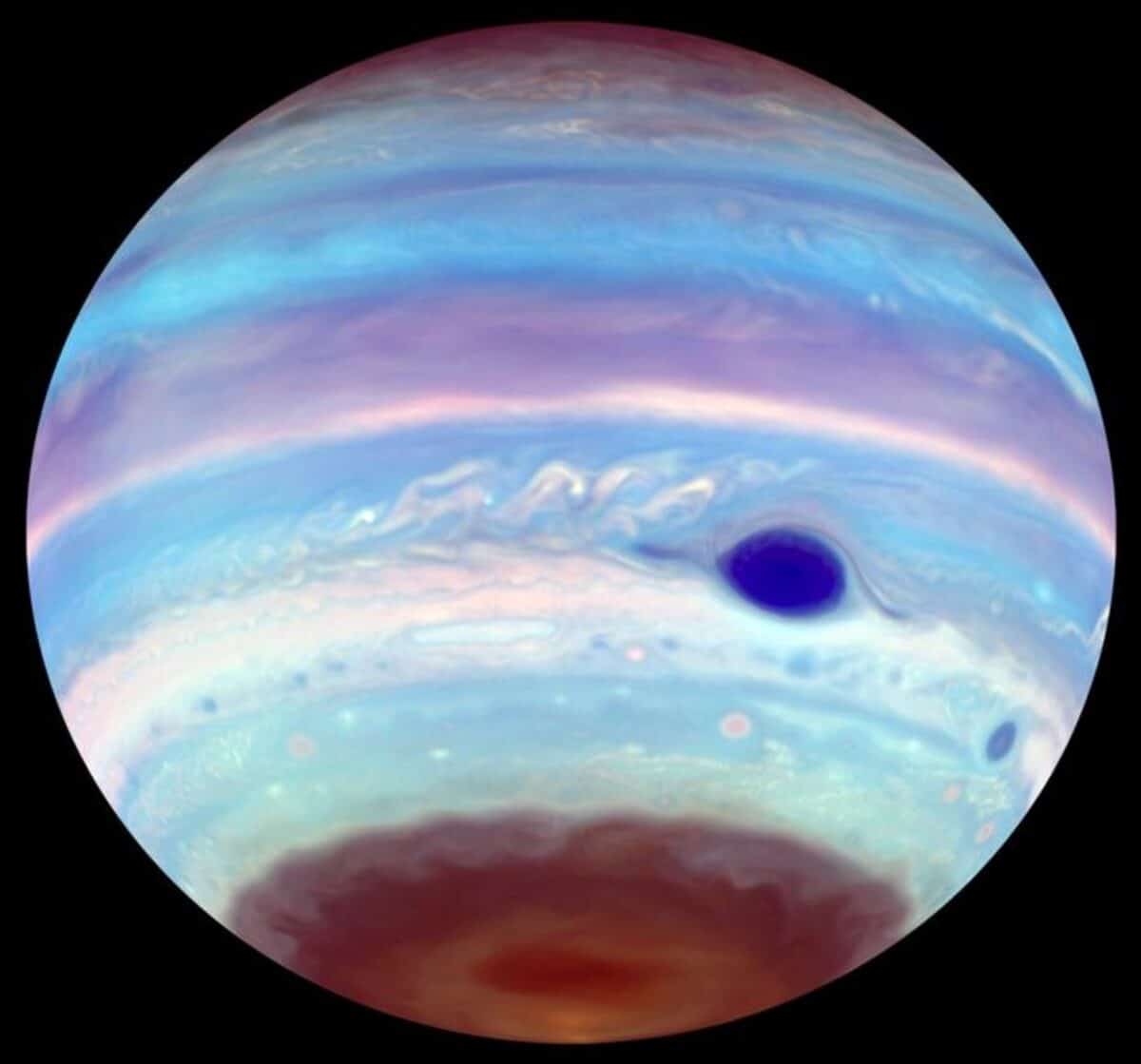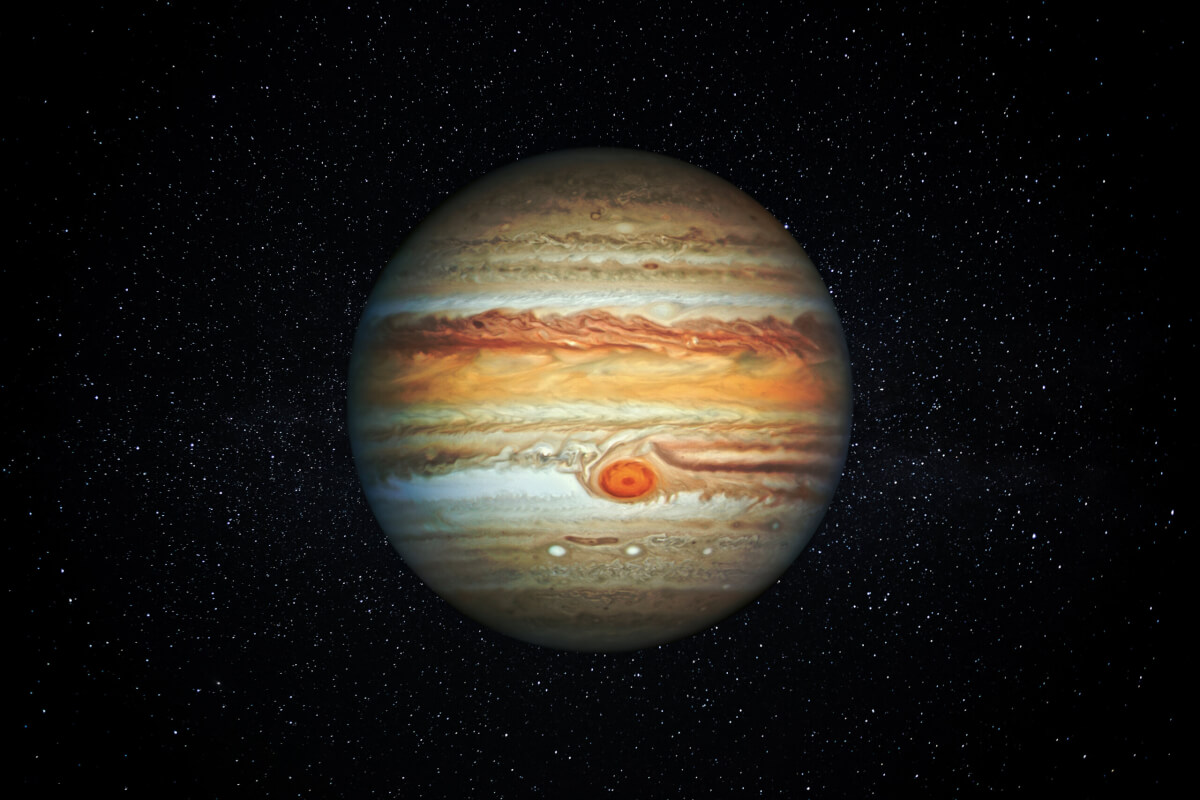
An artificially colored view of Jupiter as seen in ultraviolet light. In addition to the Great Red Spot, which appears blue, another oval feature can be seen in the brown haze at Jupiter's south pole. The oval, an area of concentrated haze, is possibly the result of mixing generated by a vortex higher up in the planet's ionosphere. These dark UV ovals also appear periodically at the north pole, though less often. (CREDIT: Troy Tsubota and Michael Wong, UC Berkeley)
In a nutshell
- Jupiter’s poles host giant, swirling dark vortices that are invisible in normal light and only show up in ultraviolet.
- These “UV-dark ovals” are not just weather: scientists believe they form when Jupiter’s powerful magnetic field physically stirs the atmosphere, pulling haze particles into spinning storms.
- The discovery, based on nearly 30 years of Hubble data, reveals a surprising and direct connection between Jupiter’s magnetosphere and its lower atmosphere, offering clues about other giant planets, too.
BERKELEY, Calif. — In the cold, swirling clouds above Jupiter’s poles, scientists have spotted something odd: dark, oval-shaped vortices visible only in ultraviolet light that come and go like ghosts. These elusive features are reshaping our understanding of how planetary magnetic fields don’t just create pretty auroras, but physically stir and shape a planet’s atmosphere.
According to a team led by researchers from the University of California, these dark spots show up near Jupiter’s south pole in about half of the images scientists looked at. The southern dark oval occurs 4 to 6 times more frequently than its northern counterpart.
Hidden Features Only Visible in UV Light
The study, published in Nature Astronomy, uncovered the dark ovals by analyzing decades of ultraviolet images from the Hubble Space Telescope. Scientists think they happen when haze in Jupiter’s upper atmosphere gets way thicker, up to 50 times denser than normal.
The ovals appear to be extensions of vortices previously detected in Jupiter’s upper atmosphere, reaching down into the stratosphere. They rotate in an anticyclonic (counterclockwise in the southern hemisphere) pattern, opposite to the surrounding cloud patterns visible in regular light.

Jupiter, the largest planet in our solar system, has been studied extensively by astronomers using various spacecraft and telescopes. One of the most productive tools for studying Jupiter has been the Hubble Space Telescope, which can capture detailed images of the planet in ultraviolet wavelengths that are blocked by Earth’s atmosphere.
For decades, astronomers have known that Jupiter’s magnetic field creates stunning auroras at its poles, similar to Earth’s northern lights but vastly more powerful. The new dark oval observations reveal more complex interactions happening beneath those auroral displays than previously understood.
A 28-Year Search Through Hubble’s Archives
Scientists believe these dark ovals form when Jupiter’s magnetic field transfers energy to the atmosphere, stirring up thick layers of haze. That haze might then trap sunlight and cause local heating in the area.
The research team analyzed 26 global maps of Jupiter taken by the Hubble Space Telescope between 1994 and 2022. This extensive timeline allowed them to determine how often the dark ovals appear and how long they typically last.

The dark ovals can develop in as little as 31 days and may persist for at least 82 days. The team also observed that they can dissipate in as little as 16 days. Intriguingly, almost all the southern dark ovals were found inside Jupiter’s main auroral oval, the region where charged particles from Jupiter’s magnetosphere create glowing auroras.
Jupiter’s polar regions have been difficult to study from Earth because of the challenging viewing angles. The poles are covered by stratospheric haze layers that appear dark in ultraviolet wavelengths, which scientists refer to as “polar hoods.” The dark ovals appear within these polar hoods.
North vs. South: A Polar Mystery
The southern dark oval (SUDO) tends to pop up in the same place near Jupiter’s south pole, and it can grow to an enormous size, roughly as big as North America. Why the southern hemisphere experiences these dark ovals much more frequently than the northern hemisphere remains something of a mystery, though the researchers suggest it may be due to differences in how Jupiter’s magnetic field aligns with its rotation axis in each hemisphere. The southern aurora is more concentrated and better aligned with Jupiter’s rotational pole, which may create conditions that favor the formation of these dark vortices.
This reveals that Jupiter’s upper and lower atmospheres are linked. Swirling winds from high above reach down, stir up haze, and briefly make the storm visible in ultraviolet. The researchers compare this process to a tornado touching down on dusty ground, similar to how a spinning column of air becomes visible when it interacts with dust on Earth.
This research helps planetary scientists understand how giant planets’ magnetic fields influence their atmospheres. Similar processes may be at work on Saturn, Neptune, Uranus, and even the thousands of gas giants orbiting distant stars.
Paper Summary
Methodology
Researchers analyzed Hubble Space Telescope data of Jupiter’s polar regions spanning 26 dates between 1994 and 2022, using both Wide Field and Planetary Camera 2 (WFPC2) and Wide Field Camera 3 (WFC3) instruments with ultraviolet filters. They processed the raw image data through a pipeline that included navigation, polar projection, image stacking, limb-darkening correction, and zonal average subtraction. For detecting dark ovals, they classified pixels as part of a dark spot if they were at least one standard deviation darker than the zonal mean. They then fitted ellipses to these dark regions and tracked their location, size, and contrast over time.
Results
The team detected UV-dark ovals in approximately 48-53% of observations of Jupiter’s south pole, compared to only about 8% for the north pole. The southern UV-dark ovals (SUDOs) were 4-6 times more common than northern ones (NUDOs). Almost all SUDOs were located inside Jupiter’s auroral oval and remained at approximately 80°S latitude and 20°W longitude. The features could form within 31 days and last at least 82 days, with dissipation occurring in as little as 16 days. Radiative transfer modeling indicated the ovals’ darkness was consistent with a 20-50 times increase in stratospheric haze particles. Additionally, the ovals showed anticyclonic rotation with an estimated period of about 590 hours.
Limitations
The study was limited by the non-continuous nature of Hubble observations, making it impossible to precisely determine how long individual dark ovals persisted. The spatial resolution at the poles was constrained by viewing geometry, especially when the subobserver latitude was high. The radiative transfer modeling could not definitively determine whether the increased darkness was due to changes in aerosol density or changes in the vertical distribution of aerosols. Additionally, the measurements of the ovals’ rotation were based on a small number of traceable features.
Funding and Disclosures
The research was supported by NASA through a grant from the Space Telescope Science Institute associated with the Outer Planet Atmospheres Legacy program. Additional support came from the National Science Foundation and NASA’s Exoplanet Research grant. The researchers declared no competing interests.
Publication Information
The paper titled “UV-dark polar ovals on Jupiter as tracers of magnetosphere–atmosphere connections” was published in Nature Astronomy (Volume 9, February 2025, pages 221-229) by Troy K. Tsubota, Michael H. Wong, Tom Stallard, Xi Zhang, and Amy A. Simon.







